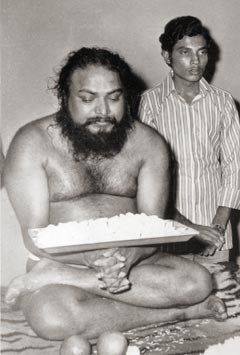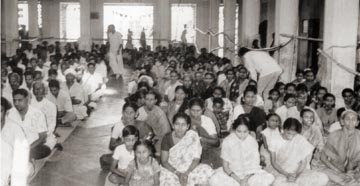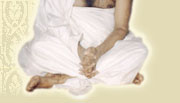PROGRAMS HOME PAGE | PREVIOUS PAGE | NEXT PAGE

“What does the ash given at the time of initiation contain?”
“It contains the power to transmit power to meditate.”
Read more about what Shivabalayogi had to say about Meditation and about Vibhuti.
More on Shivabalayogi's Meditation.
Initiation into Meditation
Each evening Swamiji was driven to the program where he sat on a dais prepared for him. He would call his interpreter and one or two local devotees, bless some vibhuti (sacred ash) and use his thumb to put some of the ash between their eyebrows. Those devotees then would give his initiation, going from person to person, placing some of the specially blessed vibhuti on third eyes, and whispering the instructions.
Swamiji watched everything, his gaze resting on each person receiving the initiation. After the last person received the touch of vibhuti and whispered instructions, Swamiji asked for the lights to be turned off and everyone meditated.
After about forty-five minutes or an hour of meditation practice, lights would be turned on and initiates asked to open their eyes. Swamiji would bless a large amount of vibhuti while one of the attendants read his basic instructions on meditation out loud. Meanwhile, other devotees would be giving each initiate a copy of the instructions, a photograph of Shivabalayogi, and a piece of the blessed vibhuti.
Ramakrishna Rao, who attended Shivabalayogi and helped organize his programs in the 1960’s, described the early programs as follows:
“In the beginning, he was most interested in giving meditation to people. Initiation was the main thing. Bhajans were secondary. Everywhere he gave programs and the programs were meditation.”
“We would visit a place and give dhyana [meditation] initiation to the maximum number of people, morning, afternoon, evening. Then in the night time if anyone was interested they sat for bhajans.”
“There would be several meditation sessions during the day, each about one hour. He would sit there in samadhi. Right in front of him we used to sit people. One meditation was for one hour, then another batch. That way there were two or three batches in the day, and then in the evening, one or two batches more. We never wasted time.”
The Gift of Meditation
In his native language of Telugu, Shivabalayogi used the expression “the gift of meditation” instead of the Telugu word for initiation. Although his gift was an empowerment, which is what initiation is, he did not like the connotation that his gift implied any obligation on the part of the recipient. With many spiritual leaders, initiation requires or implies a commitment to adhere to the practice, the teacher, or the organization.
Shivabalayogi was adamant that his initiation required no commitment or obligation. Each person was encouraged to pursue whatever teacher, tradition or practice he or she preferred. Swamiji simply asked that they also practice the meditation that he taught, saying that it would deepen whatever spiritual path they pursued.
Shivabalayogi’s technique is simple and direct. There are no sacred mantras or sounds, no rules, no postures, and no other requirements. Technique is simply focusing one's attention between the eyebrows. His meditation only requires an attitude of devotion and the transmission of Swamiji’s power through initiation and his vibhuti.
Shivabalayogi emphasized that once an individual received his initiation, there was no need for further physical contact.
The Physical Connection
Shivabalayogi’s initiation (empowerment; the gift of meditation) ordinarily requires a physical contact. The blessed ash (vibhuti) is also a physical connection.
Shivabalayogi often talked about his soul connection with devotees. Which raised the question: if we already have a soul connection, what is the need for a physical connection?
Swamiji’s answer was simple, if enigmatic: “Why were you born through your mother’s womb?”
Transmitting His Initiation
 In the very early days, Swamiji sometimes gave initiation directly. People would come up to where he was sitting, and Swamiji applied some
vibhuti on the third eye and gave the simple instructions himself. Then the person would sit and practice meditation in Swamiji’s presence.
In the very early days, Swamiji sometimes gave initiation directly. People would come up to where he was sitting, and Swamiji applied some
vibhuti on the third eye and gave the simple instructions himself. Then the person would sit and practice meditation in Swamiji’s presence.
As more and more people came to him, it became impractical for Swamiji to touch each one. Instead, he blessed devotees to transmit the initiation. Swamiji blessed some vibhuti, placed some of the ash powder on an assistant’s third eye, then give the assistant the vibhuti to transmit the initiation to others. The assistant went from person to person, placing some vibhuti on the third eye and whispering the short instructions to each individually. Virtually all the millions of people who took his initiation since 1961 received it through the touch of a devotee.
One might think that the assistants whom Swamiji chose to transmit his initiation were senior devotees. In most cases, they were, but not in the sense of having any spiritual standing of their own. Some did not even meditate regularly. Instead, they were senior in the sense that they knew and respected Swamiji enough not to entertain any ego about what they were doing. The assistant understood that he or she was not the one giving the initiation. It was Shivabalayogi.


